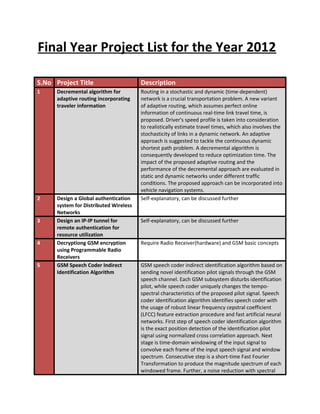Final year project list for the year 2012
- 1. Final Year Project List for the Year 2012 S.No Project Title Description 1 Decremental algorithm for Routing in a stochastic and dynamic (time-dependent) adaptive routing incorporating network is a crucial transportation problem. A new variant traveler information of adaptive routing, which assumes perfect online information of continuous real-time link travel time, is proposed. Driver's speed profile is taken into consideration to realistically estimate travel times, which also involves the stochasticity of links in a dynamic network. An adaptive approach is suggested to tackle the continuous dynamic shortest path problem. A decremental algorithm is consequently developed to reduce optimization time. The impact of the proposed adaptive routing and the performance of the decremental approach are evaluated in static and dynamic networks under different traffic conditions. The proposed approach can be incorporated into vehicle navigation systems. 2 Design a Global authentication Self-explanatory, can be discussed further system for Distributed Wireless Networks 3 Design an IP-IP tunnel for Self-explanatory, can be discussed further remote authentication for resource utilization 4 Decryptiong GSM encryption Require Radio Receiver(hardware) and GSM basic concepts using Programmable Radio Receivers 5 GSM Speech Coder Indirect GSM speech coder indirect identification algorithm based on Identification Algorithm sending novel identification pilot signals through the GSM speech channel. Each GSM subsystem disturbs identification pilot, while speech coder uniquely changes the tempo- spectral characteristics of the proposed pilot signal. Speech coder identification algorithm identifies speech coder with the usage of robust linear frequency cepstral coefficient (LFCC) feature extraction procedure and fast artificial neural networks. First step of speech coder identification algorithm is the exact position detection of the identification pilot signal using normalized cross correlation approach. Next stage is time-domain windowing of the input signal to convolve each frame of the input speech signal and window spectrum. Consecutive step is a short-time Fast Fourier Transformation to produce the magnitude spectrum of each windowed frame. Further, a noise reduction with spectral
- 2. subtraction based on spectral smoothing is carried out. In last steps we perform the frequency filtering and Discrete Cosine Transformation to receive 24 uncorrelated cepstral coefficients per frame as a result. Speech coder identification is completed with fast artificial neural network classification using the input feature vector of 24 LFCC coefficients, giving a result of identified speech coder. 6 Distributed fault detection of Wireless Sensor Networks (WSNs) have become a new wireless sensor networks information collection and monitoring solution for a variety of applications. Faults occurring to sensor nodes are common due to the sensor device itself and the harsh environment where the sensor nodes are deployed. In order to ensure the network quality of service it is necessary for the WSN to be able to detect the faults and take actions to avoid further degradation of the service. 7 Efficient code distribution in The need to re-programme a wireless sensor network may wireless sensor networks arise from changing application requirements, bug fixes, or during the application development cycle. Once deployed, it will be impractical at best to reach each individual node. Thus, a scheme is required to wirelessly re-programme the nodes. 8 A novel agent-based user- Wireless sensor networks generally have three kinds of network communication model objects: sensor nodes, sinks, and users that send queries and in wireless sensor networks receive data via the sinks. In addition, the user and the sinks are mostly connected to each other by infrastructure networks. The users, however, should receive the data from the sinks through multi-hop communications between disseminating sensor nodes if such users move into the sensor networks without infrastructure networks. To support mobile users, previous work has studied various user mobility models. Nevertheless, such approaches are not compatible with the existing data-centric routing algorithms, and it is difficult for the mobile users to gather data efficiently from sensor nodes due to their mobility You can also present any other idea relevant to Data Communication, Communication Networks, Wireless Networks or Digital Communication for further discussion


